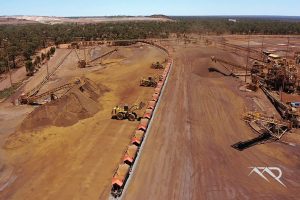As Australia’s next lithium producer edges closer towards first construction of its flagship project, a successful testwork program has Core Lithium considering the downstream processing opportunities for its Finniss project in the Northern Territory.
Adelaide-based Core (ASX: CXO) told the market this week that a scoping-level test on lithium spodumene concentrate from its Finniss project, located just south of Darwin, was capable of producing battery-grade lithium hydroxide monohydrate (LH), a quality which effectively certifies Finniss’ product as suitable for use in the high-end lithium battery, renewable energy and electric vehicle industries.
In other news:
- Rio Tinto awards Brockman 2 mining contract to CSI
- St George provides exploration update on Mt Alexander nickel-copper sulphide project, WA
- Australian Potash announced SBM to acquire 70% interest in Lake Wells Gold Project
- Torrens EL7331 Paves the Way for Gold Drilling at Northwood Hill
- Australian Potash Identified Massive Nickel Sulphide Targets at Laverton Downs Project
The scoping-level testwork program, which closely followed the recent award of Major Project Status for Finniss by the Federal Government, showed that the conventional ‘direct’ flowsheet (which involves decrepitation, sulfation baking/water leaching, purification, Glauber salt crystallisation and lithium hydroxide crystallisations) can be applied to the processing of the mineral concentrate sample to produce battery-grade LH.
Core expects to turn the first sod at Finniss before year-end, with first construction contingent on a continued improvement in global lithium markets (Benchmark’s lithium price index rose by 10.8% in March alone) and a final investment decision (FID) on the project by the company’s senior leadership team. An updated definitive feasibility study (DFS) on Finniss is also expected prior to FID.
Following the success of the LH testwork, Core also told the market it is considering the downstream value potential of Finniss, with the project’s proximity to the adjacent Middle-Arm industrial infrastructure at Darwin Port making it a likely candidate for the home of the future facility.
“This announcement confirms that battery-grade lithium hydroxide suitable for high-end uses in the lithium battery, renewable energy and electric vehicle industries, can be produced from Core’s excellent quality lithium concentrate produced from the Finniss project,” Core managing director Stephen Biggins said.
“This successful proof-of-concept testwork provides Core, and our customers, the confidence in utilising Finniss lithium concentrates in the global lithium battery supply chain.
“Together with the recent award of Major Project Status from the Federal Government, this program lays a foundation for Core to explore the potential of adding downstream processing infrastructure to our portfolio, incorporating the strong synergies with the infrastructure at the nearby Middle-Arm Industrial Precinct at Darwin Port and aligning with Australia’s national Modern Manufacturing Strategy and expansion of the global lithium battery supply chain.”
Core shares closed the week at 25.5¢ per share, up from 22¢ on Tuesday.
Next-gen batteries to make EVs cheaper
On the other end of the supply chain, Japanese tech giant Panasonic has signaled it is readying to get a next-generation lithium battery to market.
Dubbed ‘the beer can battery’ for its similar size and shape to that of a beer can, the next-gen technology was showcased by Tesla in September last year as the key to significantly dropping the retail prices for future EVs.
The beer can cells are about five times larger than what you would currently find in a Tesla vehicle, meaning that the 4,000-8,000 cells found in a Tesla vehicle could be reduced to around 500.
Tesla has mandated Panasonic – the carmaker’s longest-serving supplier of batteries – to begin producing the larger cells, but industry experts have told media that there are “significant technological issues to get past” with these larger cells, most notably overheating as heat struggles to escape from the cell’s centre – an unfortunate side-effect of their larger size.
However, Panasonic says it is confident that it can safely produce the cells and is currently setting up a prototype production line for the new batteries. Tesla, meanwhile, also plans to make the cells in-house.
Communicating your story to all stakeholders, including shareholders and prospective investors, is key. To discuss your strategic communications needs, contact Cannings Purple’s Director of Investor Relations Peter Klinger.



